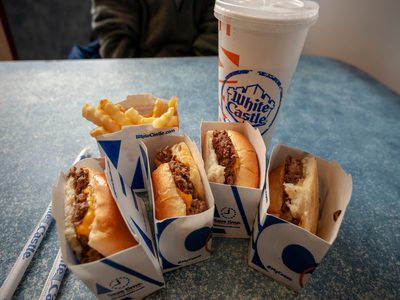- September 5, 2023
- Posted by: Strategic Franchise Brokers
- Category: Franchising

White Castle, the iconic American fast-food chain known for its small, square-shaped burgers, has a history that stretches back over a century. It holds a special place in the annals of the fast-food industry, not only for its unique approach to burgers but also for its pioneering efforts in standardizing food quality and restaurant operations. In this comprehensive overview, we will explore the rich history of White Castle, from its humble beginnings to its enduring impact on the fast-food landscape.
I. The Innovative and Unique Approach of White Castle to the Burger Market: 1921-1940
The story of White Castle begins in 1921 when Walter Anderson and Billy Ingram opened the first White Castle restaurant in Wichita, Kansas. This was a time when hamburgers were primarily associated with dubious quality and hygiene, often cooked and served in unsanitary conditions. White Castle aimed to change that perception by introducing a novel concept: the “slider.”
1. The Birth of the Slider:
- White Castle’s founders developed a unique burger patty, consisting of a small, square-shaped beef patty with holes to promote even cooking.
- These small burgers were cooked with a technique that involved steaming them over a bed of onions, imparting a distinct flavor and aroma.
- The term “slider” likely originated from the ease with which these small burgers could slide down the throat, thanks to their soft texture and size.
2. Standardization and Quality:
- White Castle was a pioneer in emphasizing standardization in food preparation and restaurant operations.
- The company adopted strict hygiene practices, including using stainless steel countertops and requiring employees to wear clean uniforms.
- This commitment to cleanliness and consistency set White Castle apart and contributed to its early success.
3. Expansion and Growth:
- The first White Castle restaurant in Wichita proved to be a hit, and the company soon expanded to other cities.
- White Castle introduced the concept of “fast food” to America, with an emphasis on quick service and uniform quality.
II. The Difficult Years: 1940s-1960s
The 1940s and 1950s brought challenges to White Castle as it faced competition from other fast-food chains and changes in consumer preferences. Despite these difficulties, the company remained committed to its unique burger style and brand identity.
1. Competition and Expansion:
- In the post-World War II era, competition in the fast-food industry increased with the emergence of other chains like McDonald’s and Burger King.
- White Castle expanded its menu to include items like french fries and milkshakes but continued to focus on its distinctive sliders.
2. Challenges and Adaptations:
- White Castle faced challenges in maintaining its market share and relevance as consumer tastes began to shift.
- The company experimented with changes, such as introducing a circular patty called the “Craver” in the 1950s, but the square slider remained its hallmark.
III. White Castle’s Unique Brand and Cultural Impact: 1970s-1990s
While White Castle faced challenges in the fast-food industry, it also carved out a unique niche for itself. Its distinct brand identity and cultural significance made it a beloved institution among its loyal customers.
1. Pop Culture and Iconic Status:
- White Castle’s distinctive sliders and iconic packaging became a recurring theme in popular culture, appearing in movies, television shows, and songs.
- The restaurant chain’s status as a late-night dining destination endeared it to many who craved its small, flavorful burgers.
2. Innovations and Adaptations:
- White Castle continued to innovate, introducing new menu items and modernizing its restaurants to cater to changing consumer preferences.
- The company maintained its focus on cleanliness and consistency as part of its commitment to quality.
IV. The 21st Century and Beyond
White Castle has continued to adapt and evolve in the 21st century while staying true to its core identity. The company has embraced new technologies, expanded its menu, and ventured into sustainability initiatives.
1. Technological Advancements:
- White Castle introduced online ordering and mobile app options for customers, enhancing convenience and accessibility.
- The company also explored automation in the kitchen to streamline operations and maintain food quality.
2. Menu Expansions:
- White Castle expanded its menu to include a variety of options, catering to changing dietary preferences, including vegetarian and vegan choices.
- These additions complemented its classic sliders and diversified its offerings.
3. Sustainability Efforts:
- White Castle has taken steps to minimize its environmental impact by adopting sustainable practices in its supply chain and operations.
- Initiatives like sustainable packaging and responsible sourcing of ingredients demonstrate its commitment to environmental stewardship.
V. The Legacy of White Castle
White Castle’s legacy in the fast-food industry is undeniable. It pioneered many of the practices and standards that are now commonplace in the industry, including the concept of fast food, cleanliness, and consistency. Its unique slider has remained a cultural icon for generations of Americans, and its impact on popular culture is enduring.
1. A Trailblazer in Fast Food:
- White Castle laid the foundation for the fast-food industry, setting high standards for quality and cleanliness.
- Its commitment to innovation and consistency influenced the broader foodservice landscape.
2. Iconic Cultural Status:
- The White Castle slider has become a symbol of late-night indulgence and a staple in the American cultural lexicon.
- References to White Castle are abundant in movies, television, literature, and music, solidifying its place in pop culture.
3. Evolving and Adapting:
- White Castle’s ability to evolve and adapt to changing consumer preferences has allowed it to remain relevant over the decades.
- The company’s emphasis on technology, sustainability, and menu diversity demonstrates its commitment to staying current.
VI. Conclusion: The Enduring Legacy of White Castle
White Castle’s journey from its humble beginnings in Wichita, Kansas, to its status as a cultural icon in the fast-food industry is a testament to its innovation, commitment to quality, and ability to adapt. Its small, square burgers have left an indelible mark on American food culture, and its enduring legacy continues to influence the industry today. As the world of fast food continues to evolve, White Castle remains a shining example of how a brand can stay true to its roots while embracing the future.
For more information on how to franchise and how to develop a food service franchise system, contact Chris Conner, President, Franchise Marketing Systems (FMS Franchise): www.FMSFranchise.com or [email protected]
